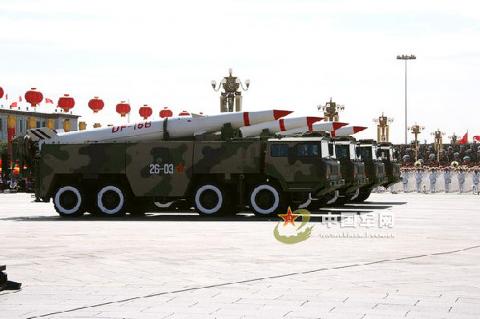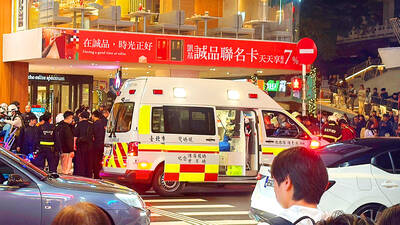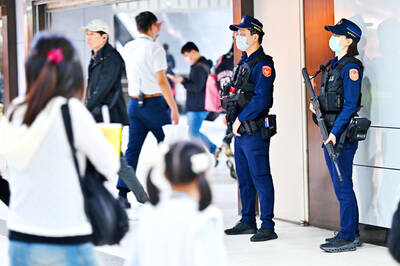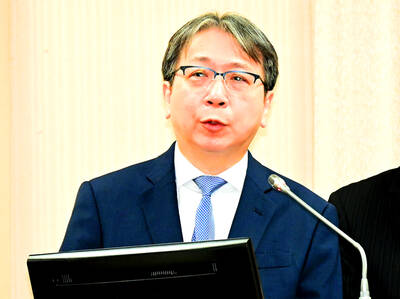A new longer-range ballistic missile allegedly deployed by China and the introduction of multiple warhead capabilities could render obsolete Taiwan’s most advanced missile interceptors, analysts said yesterday.
National Security Bureau (NSB) Director Tsai Der-sheng (蔡得勝) told the legislature on Wednesday that China had recently begun deploying Dong Feng-16 (DF-16) ballistic missiles with a range of between 800km and 1,000km, and that some were targeting Taiwan.
One US expert with years of experience monitoring developments in China’s missile arsenal told the Taipei Times that while literature on the DF-16 was scarce, the fact that a different designation had been referenced implied that the system was sufficiently different from existing missiles.

Photo: China Military Online
Another, Rick Fisher, a senior fellow at the International Assessment and Strategy Center in Washington, said chances the DF-16 is the “real deal” were high, adding that the new system would likely incorporate advances in solid rocket fuel, guidance and warhead design. He admitted this was the first time he had seen references to the DF-16 designation.
Alarmingly, the faster re-entry of a longer-range ballistic missile such as the DF-16 would greatly reduce the effectiveness of Taiwan’s PAC-3 missile interceptors that were acquired at great cost from the US and which are still in the process of being deployed.
The longer the range of a ballistic missile, the higher it must climb to reach its target and the higher it climbs, the more time it takes for it to fall to the ground, giving gravity more time to accelerate the descent of the warhead at a rate of about 9.8m per second squared.
“All the PAC-3s are not yet in the field, but when they are, they can potentially be defeated by the faster 1,000km DF-16,” Fisher said.
In addition, new long-range missiles would give China’s leadership the ability to make “peace gestures,” such as withdrawing older DF-15s, without any substantial reduction of military pressure on Taiwan, he said.
The removal of some missiles targeting Taiwan has been touted as a potential “goodwill” gesture by Beijing to help President Ma Ying-jeou (馬英九) get re-elected next year.
Ballistic missiles with a range such as that attributed to the DF-16 could be deployed at the Second Artillery’s 52 Base in Anhui Province and target Taiwan as well as US bases in the region, such as Okinawa and Guam.
According to a study by the Project 2049 Institute, 52 Base oversees five short-range ballistic missile (SRBM) brigades and as many as three medium-range ballistic missile brigades. It remains unclear whether 52 Base is being equipped with a new brigade for the DF-16 or whether they would replace older SRBMs.
Wendell Minnick, Asia bureau chief for Defense News, was more skeptical on the DF-16 representing a new type of missile, saying it was likely a variant of the existing DF-15, which has a range of about 600km.
“Honestly, I can’t see how all the US analysts missed it, if it is ‘deployed,’” Minnick said. “I suspect he [Tsai] is saying the DF-15 extended range is the new ‘DF-16,’ but the lack of details during his testimony annoys me to no end.”
“It’s possible they [the government] are trying to scare the US into releasing new F-16 fighters and submarines,” Minnick said.
During his presentation, Tsai also said that most of China’s missiles now had multiple warheads capable of hitting different targets, such as radar sites and planes at airports.
While it is known that the DF-21 “aircraft carrier killer” — which Tsai said was also recently deployed — has multiple warheads, news that smaller missiles in the Chinese arsenal have multiple reentry vehicles (MRVs) would be a worrying development, Fisher said.
“PAC-3s can only handle one incoming missile target, not [several] MRVs,” he said, adding that the US had recently canceled a missile defense program intended to give missile interceptors the ability to take out MRVs.

TRAGEDY STRIKES TAIPEI: The suspect died after falling off a building after he threw smoke grenades into Taipei Main Station and went on a killing spree in Zhongshan A 27-year-old suspect allegedly threw smoke grenades in Taipei Main Station and then proceeded to Zhongshan MRT Station in a random killing spree that resulted in the death of the suspect and two other civilians, and seven injured, including one in critical condition, as of press time last night. The suspect, identified as a man surnamed Chang Wen (張文), allegedly began the attack at Taipei Main Station, the Taipei Fire Department said, adding that it received a report at 5:24pm that smoke grenades had been thrown in the station. One man in his 50s was rushed to hospital after a cardiac arrest

PUBLIC SAFETY: The premier said that security would be tightened in transport hubs, while President Lai commended the public for their bravery The government is to deploy more police, including rapid response units, in crowded public areas to ensure a swift response to any threats, President William Lai (賴清德) said yesterday after a knife attack killed three people and injured 11 in Taipei the previous day. Lai made the remarks following a briefing by the National Police Agency on the progress of the investigation, saying that the attack underscored the importance of cooperation in public security between the central and local governments. The attack unfolded in the early evening on Friday around Taipei Main Station’s M7 exit and later near the Taipei MRT’s Zhongshan

SAFETY FIRST: Double the number of police were deployed at the Taipei Marathon, while other cities released plans to bolster public event safety Authorities across Taiwan have stepped up security measures ahead of Christmas and New Year events, following a knife and smoke bomb attack in Taipei on Friday that left four people dead and 11 injured. In a bid to prevent potential copycat incidents, police deployments have been expanded for large gatherings, transport hubs, and other crowded public spaces, according to official statements from police and city authorities. Taipei Mayor Chiang Wan-an (蔣萬安) said the city has “comprehensively raised security readiness” in crowded areas, increased police deployments with armed officers, and intensified patrols during weekends and nighttime hours. For large-scale events, security checkpoints and explosives

ON ALERT: Taiwan’s partners would issue warnings if China attempted to use Interpol to target Taiwanese, and the global body has mechanisms to prevent it, an official said China has stationed two to four people specializing in Taiwan affairs at its embassies in several democratic countries to monitor and harass Taiwanese, actions that the host nations would not tolerate, National Security Bureau (NSB) Director-General Tsai Ming-yen (蔡明彥) said yesterday. Tsai made the comments at a meeting of the legislature’s Foreign Affairs and National Defense Committee, which asked him and Minister of National Defense Wellington Koo (顧立雄) to report on potential conflicts in the Taiwan Strait and military preparedness. Democratic Progressive Party (DPP) Legislator Michelle Lin (林楚茵) expressed concern that Beijing has posted personnel from China’s Taiwan Affairs Office to its